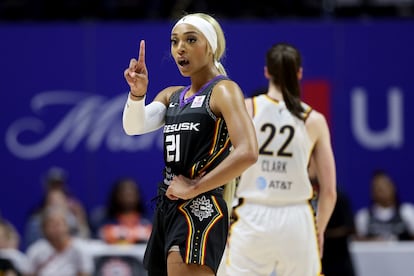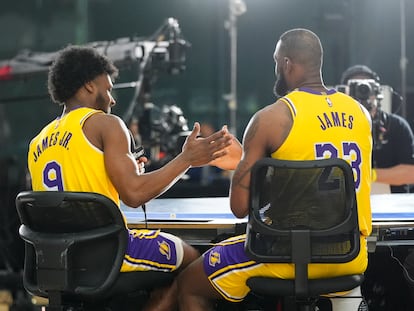Racism, sexism and LGBTQphobia tarnish the rise of women’s basketball in the US
Female players in the league have been targeted for racist and sexist attacks in the wake of the sport’s growing popularity thanks to young stars like Caitlin Clark

The Women’s National Basketball Association (WNBA) has had a historic season. Since its creation in 1996, the league’s top division had never sold so many tickets for its games or had such a large television audience. However, the media spotlight in recent weeks has not been on this success, but on the wave of racist attacks of which several of the players have been victims.
The Instagram profiles and other social media accounts kept by these athletes — many of whom are Black and members of the LGBTQ+ community — have seen a proliferation of hateful comments, insults and even threats against. Some people believe this is a response to the growing popularity of the women’s league. The attacks reached a tipping point at the end of September, during the playoff games between the Connecticut Sun and the Indiana Fever. Before the second game, Connecticut Sun guard DiJonai Carrington shared on her Instagram account an anonymous email she had received containing sexual assault and death threats.
The day after the game, the WNBA issued an official statement condemning the hateful comments that, like Carrington, several athletes had been receiving. She did not make any further statements about the threats, but Indiana Fever point guard Caitlin Clark — the young star of the team, white and one of the key reasons for understanding the rise of the competition’s popularity this year — and her coach, Christie Sides, did. They denounced before journalists the “racist rhetoric” with which the players are being tormented. Clark, winner of the WNBA Rookie of the Year award, said that those who insult “aren’t fans. Those are trolls, and it’s a real disservice to the people in our league, the organization, the WNBA.”
Attacks on female players are not unusual in American sport. Despite the national culture’s maxim that this should be an apolitical space, it often ends up being another battlefield for polarization. It is worth recalling how, in 2019, the national team’s female soccer players became targets of former president Donald Trump and his supporters for their criticism of the president and the Republican Party’s anti-LGBTQ+ policies, or when transgender athletes such as swimmer Lia Thomas have been victims of hate campaigns.
Unlike the ostracism that male athletes are often subjected to when they take a political stance (such as NFL player Colin Kaepernick, who knelt during the national anthem to condemn racism), there is greater solidarity among female players in women’s sports. Following the threats to Carrington, players and former players from other teams came to her defense.
Connecticut Sun coach Stephanie White said that in her entire career she had “never seen anything like this.” “We’ve seen a lot of racism, sexism, homophobia, transphobia throughout the course of our country. Sport is no exception, and it’s unacceptable to be quite honest,” she said in late September. In a recent report, The Athletic noted that the harassment of WNBA players is taking a toll on their mental health. “A few players have made more drastic moves, deactivating some of their social media accounts or heavily limiting their engagement, despite the clear and often critical income potential that comes from marketing directly to fans,” the piece reads. The WNBA wants to foster a healthy atmosphere in order to continue its successful season, without having yet announced concrete measures to protect the players.
Sign up for our weekly newsletter to get more English-language news coverage from EL PAÍS USA Edition
Tu suscripción se está usando en otro dispositivo
¿Quieres añadir otro usuario a tu suscripción?
Si continúas leyendo en este dispositivo, no se podrá leer en el otro.
FlechaTu suscripción se está usando en otro dispositivo y solo puedes acceder a EL PAÍS desde un dispositivo a la vez.
Si quieres compartir tu cuenta, cambia tu suscripción a la modalidad Premium, así podrás añadir otro usuario. Cada uno accederá con su propia cuenta de email, lo que os permitirá personalizar vuestra experiencia en EL PAÍS.
¿Tienes una suscripción de empresa? Accede aquí para contratar más cuentas.
En el caso de no saber quién está usando tu cuenta, te recomendamos cambiar tu contraseña aquí.
Si decides continuar compartiendo tu cuenta, este mensaje se mostrará en tu dispositivo y en el de la otra persona que está usando tu cuenta de forma indefinida, afectando a tu experiencia de lectura. Puedes consultar aquí los términos y condiciones de la suscripción digital.
More information
Archived In
Últimas noticias
Maduro pleads not guilty before the federal court in New York: ‘I am still the president of Venezuela’
A new test can detect Alzheimer’s from a finger prick
UN team enters Sudanese city of El Fasher after paramilitary massacre: ‘It’s like a ghost town’
A recipe for resistance: Indigenous peoples politicize their struggles from the kitchen
Most viewed
- Gilles Lipovetsky: ‘If you want to live better and fall in love, take Prozac, don’t look to philosophy’
- Alain Aspect, Nobel laureate in physics: ‘Einstein was so smart that he would have had to recognize quantum entanglement’
- Alvin Hellerstein, a 92-year-old judge appointed by Bill Clinton, to preside over Maduro’s trial in New York
- Why oil has been at the center of Venezuela-US conflicts for decades
- Cuba confirms death of 32 of its citizens in the US attack against Venezuela











































